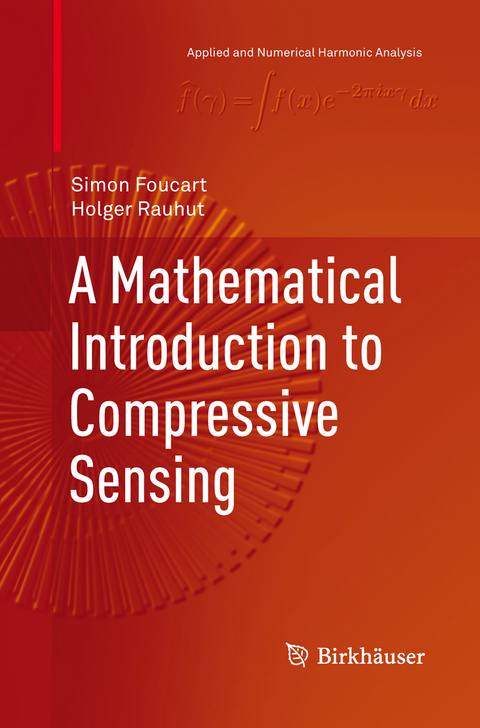
A Mathematical Introduction to Compressive Sensing
Seiten
2015
|
Softcover reprint of the original 1st ed. 2013
Springer-Verlag New York Inc.
978-1-4939-0063-3 (ISBN)
Springer-Verlag New York Inc.
978-1-4939-0063-3 (ISBN)
At the intersection of mathematics, engineering, and computer science sits the thriving field of compressive sensing. A Mathematical Introduction to Compressive Sensing uses a mathematical perspective to present the core of the theory underlying compressive sensing.
At the intersection of mathematics, engineering, and computer science sits the thriving field of compressive sensing. Based on the premise that data acquisition and compression can be performed simultaneously, compressive sensing finds applications in imaging, signal processing, and many other domains. In the areas of applied mathematics, electrical engineering, and theoretical computer science, an explosion of research activity has already followed the theoretical results that highlighted the efficiency of the basic principles. The elegant ideas behind these principles are also of independent interest to pure mathematicians.
A Mathematical Introduction to Compressive Sensing gives a detailed account of the core theory upon which the field is build. With only moderate prerequisites, it is an excellent textbook for graduate courses in mathematics, engineering, and computer science. It also serves as a reliable resource for practitioners and researchers in these disciplines who want to acquire a careful understanding of the subject. A Mathematical Introduction to Compressive Sensing uses a mathematical perspective to present the core of the theory underlying compressive sensing.
At the intersection of mathematics, engineering, and computer science sits the thriving field of compressive sensing. Based on the premise that data acquisition and compression can be performed simultaneously, compressive sensing finds applications in imaging, signal processing, and many other domains. In the areas of applied mathematics, electrical engineering, and theoretical computer science, an explosion of research activity has already followed the theoretical results that highlighted the efficiency of the basic principles. The elegant ideas behind these principles are also of independent interest to pure mathematicians.
A Mathematical Introduction to Compressive Sensing gives a detailed account of the core theory upon which the field is build. With only moderate prerequisites, it is an excellent textbook for graduate courses in mathematics, engineering, and computer science. It also serves as a reliable resource for practitioners and researchers in these disciplines who want to acquire a careful understanding of the subject. A Mathematical Introduction to Compressive Sensing uses a mathematical perspective to present the core of the theory underlying compressive sensing.
1 An Invitation to Compressive Sensing.- 2 Sparse Solutions of Underdetermined Systems.- 3 Basic Algorithms.- 4 Basis Pursuit.- 5 Coherence.- 6 Restricted Isometry Property.- 7 Basic Tools from Probability Theory.- 8 Advanced Tools from Probability Theory.- 9 Sparse Recovery with Random Matrices.- 10 Gelfand Widths of l1-Balls.- 11 Instance Optimality and Quotient Property.- 12 Random Sampling in Bounded Orthonormal Systems.- 13 Lossless Expanders in Compressive Sensing.- 14 Recovery of Random Signals using Deterministic Matrices.- 15 Algorithms for l1-Minimization.- Appendix A Matrix Analysis.- Appendix B Convex Analysis.- Appendix C Miscellanea.- List of Symbols.- References.
| Erscheinungsdatum | 25.07.2016 |
|---|---|
| Reihe/Serie | Applied and Numerical Harmonic Analysis |
| Zusatzinfo | XVIII, 625 p. |
| Verlagsort | New York |
| Sprache | englisch |
| Maße | 155 x 235 mm |
| Themenwelt | Mathematik / Informatik ► Informatik ► Theorie / Studium |
| Mathematik / Informatik ► Mathematik ► Algebra | |
| Mathematik / Informatik ► Mathematik ► Analysis | |
| Mathematik / Informatik ► Mathematik ► Angewandte Mathematik | |
| Technik ► Elektrotechnik / Energietechnik | |
| Technik ► Nachrichtentechnik | |
| ISBN-10 | 1-4939-0063-3 / 1493900633 |
| ISBN-13 | 978-1-4939-0063-3 / 9781493900633 |
| Zustand | Neuware |
| Haben Sie eine Frage zum Produkt? |
Mehr entdecken
aus dem Bereich
aus dem Bereich
was jeder über Informatik wissen sollte
Buch | Softcover (2024)
Springer Vieweg (Verlag)
CHF 53,15
Grundlagen – Anwendungen – Perspektiven
Buch | Softcover (2022)
Springer Vieweg (Verlag)
CHF 48,95
Eine Einführung in die Systemtheorie
Buch | Softcover (2022)
UTB (Verlag)
CHF 34,95


